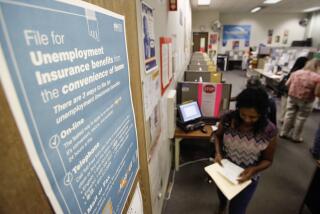California’s job market was surging before the Delta variant took hold

- Share via
When the COVID-19 pandemic hit last year, Gregory Flynn, chief executive of Flynn Restaurant Group in San Francisco, the nation’s largest franchise operator, furloughed some 29,000 employees in 44 states, including more than 5,000 in California.
“It was a crazy time,” he recalled. “But we brought most of them back within a couple of months.”
Revenue dropped in 2020, but now, despite labor shortages and supply chain disruptions, sales at the group’s Applebee’s eateries, including 80 outlets in California, are up 10% over 2019, thanks to both in-house dining and takeout.
Hiring at restaurants helped California employers add a robust 114,400 nonfarm jobs last month, boosting payrolls to 16.52 million, state officials reported Friday.
The leisure and hospitality sector, which includes restaurants, bars and theme parks, accounted for nearly half the rise after suffering the most from the COVID-19 recession.
But as a recovering economy pulled more Californians back to work last month and cooped-up residents, many vaccinated, ventured out after months of isolation, the shadow of the coronavirus’ Delta variant loomed.
The retreat by mothers with outside employment is a setback for women’s advances, both in corporate America and in narrowing the pay gap with men.
“People came out of hibernation,” said Sung Won Sohn, an economist at Loyola Marymount University. “But the Delta virus remains a wildcard. If another wave of the pandemic continues, economic growth will suffer.”
July’s employment data were collected during the second week of the month before infections began surging. More than 12,300 Californians have caught the virus in the last week, and cases rose by more than 25% over the last 14 days. More than a third of residents have yet to receive a vaccine shot.
The Golden State’s unemployment rate held steady in July at 7.6%, the lowest since the pandemic hit in March 2020, but above the U.S. level of 5.6%.
California’s labor force participation rate ticked up to 60.9% from a low point of 59.2% in September 2020, but the state has recovered just 58.3% of the 2,714,800 jobs lost in March and April of last year due to the pandemic.
“It’s great that the state saw a sixth consecutive month of 100,000-plus job growth,” said Enrique Lopezlira, a UC Berkeley economist. “But many workers are still on the sidelines. Employers need to improve the quality of jobs, not just wages.”
The leisure and hospitality industry remains 427,000 jobs shy of its pre-pandemic peak in February 2020 despite pay raises, bonuses and improved benefits to lure workers off the sidelines.
Month over month, government jobs rose by 35,900 in July as summer schools opened and teachers began returning to work. The broad “other services” category, which includes hair salons, auto repair shops and other businesses, grew by 6,400 positions. Professional and business services jobs increased by 4,000.
Manufacturing lost 4,500 jobs in the largest drop of any sector, while financial activities lost 1,400 positions.
Going forward, Lynn Reaser, an economist with Point Loma Nazarene University in San Diego, is concerned the Delta variant could weigh on consumers’ willingness to spend.
“More importantly, COVID concerns could affect the ability of parents to find child care even as schools reopen, prolonging the struggle of companies to fill open positions,” she said.
Jobs will come back and the state’s economy will recover faster than the nation’s, a UCLA forecast says, led by consumer spending, tech jobs and home-building
Another issue is the looming expiration of federal supplemental unemployment benefits of $300 per week, which end on Sept. 6.
Small businesses face particularly steep challenges. “Glad to see big businesses starting to hire again, but on the main streets of America, it’s a different story,” said John Kabateck, California state director for the National Federation of Independent Business, after the group’s monthly Small Business Economic Trends report this month showed waning optimism.

Michaela Mendelsohn, chief executive of Pollo West Corp., with 200 employees in Los Angeles and Ventura counties, hired back furloughed workers and paid her rent last year with a $778,000 federal Paycheck Protection Program loan, now forgiven.
Business had dropped by 35% in the first three months of the pandemic, but sales bounced back as customers flocked to her El Pollo Loco drive-through windows and expanded patios. Revenue is now up 9% over last year, and this week, she was scouting locations for a seventh restaurant.
With many service workers reluctant to return to their jobs, Mendelsohn is fending off labor shortages by boosting wages by 10%, expanding paid time off from three days a year to five days, and offering bonuses to employees who remain on the job.
“Our bonus total will reach $75,000 this year,” she said. “That’s quite a bit of money for us.”
Still, Mendelsohn is worried. The government, she said, “can only put money in people’s pockets to stimulate the economy for so long. When we stop doing that, what’s going to happen? And with the end of eviction and foreclosure moratoriums, many people may not be able to keep up.”
As for the Delta variant, “we don’t know what the future will bring,” she said. “The pandemic is not really behind us. Until we hit high enough vaccination numbers, we won’t be out of this.”
Flynn, the San Francisco conglomerate chief, is also concerned. With the virus untamed, he would like to see a government vaccine mandate covering employees at all businesses.
“San Francisco and New York are requiring vaccinations, and it’s a great starting point,” he said. “But it doesn’t go far enough, because if you require it only of restaurants and movie theaters and gyms, those employees can go to work at any retailer across the street.”
Even with all the uncertainties, however, he remains bullish on the Golden State. “I would never bet against California,” he said. “The economy is large and diverse. The recovery is strong.”
More to Read
Inside the business of entertainment
The Wide Shot brings you news, analysis and insights on everything from streaming wars to production — and what it all means for the future.
You may occasionally receive promotional content from the Los Angeles Times.











